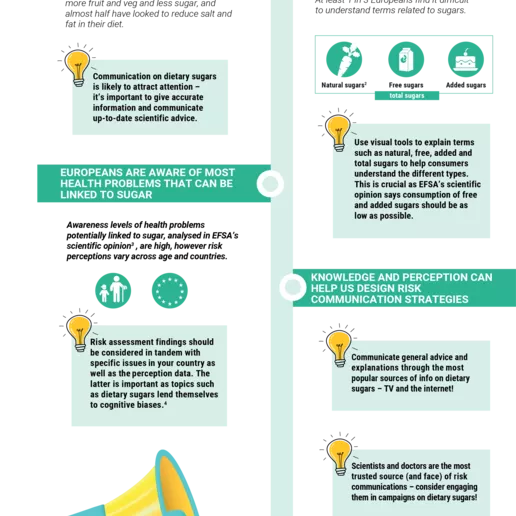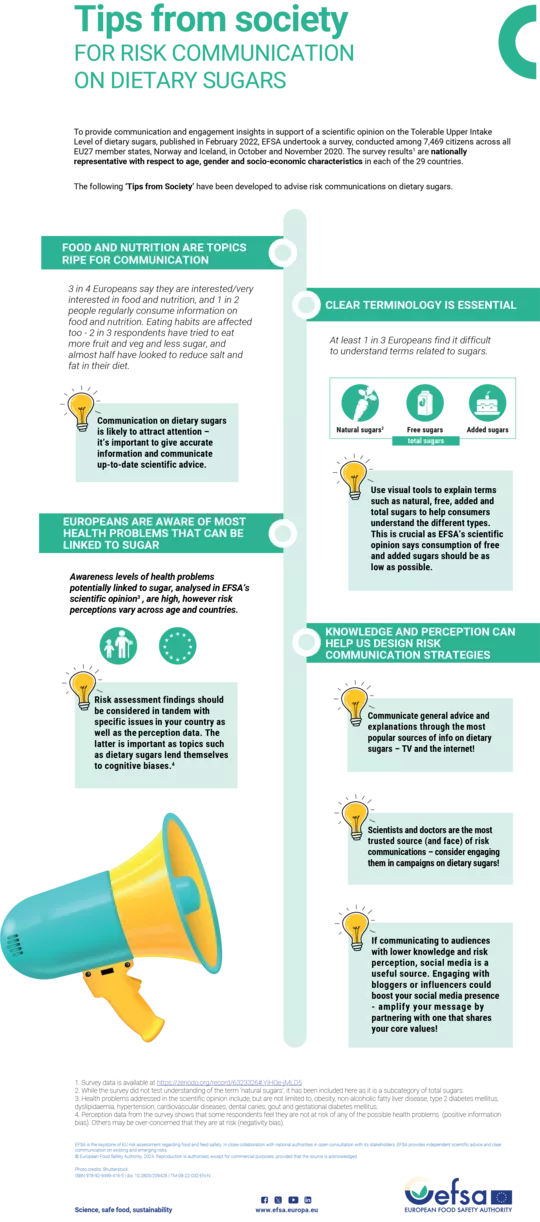Tips from society for risk communication on dietary sugars


To provide communication and engagement insights in support of a scientific opinion on the Tolerable Upper Intake Level of dietary sugars, published in February 2022, EFSA undertook a survey, conducted among 7,469 citizens across all EU27 member states, Norway and Iceland, in October and November 2020. The survey results[1] are nationally representative with respect to age, gender and socio-economic characteristics in each of the 29 countries.
The following ‘Tips from Society’ have been developed to advise risk communications on dietary sugars.
Food and nutrition are topics ripe for communication
3 in 4 Europeans say they are interested/very interested in food and nutrition, and 1 in 2 people regularly consume information on food and nutrition. Eating habits are affected too - 2 in 3 respondents have tried to eat more fruit and veg and less sugar, and almost half have looked to reduce salt and fat in their diet.
Communication on dietary sugars is likely to attract attention – it’s important to give accurate information and communicate up-to-date scientific advice.
Clear terminology is essential
At least 1 in 3 Europeans find it difficult to understand terms related to sugars.
Total sugars:
- Natural sugars[2]
- Free sugars
- Added sugars
Use visual tools to explain terms such as natural, free, added and total sugars to help consumers understand the different types. This is crucial as EFSA’s scientific opinion says consumption of free and added sugars should be as low as possible.
Europeans are aware of most health problems that can be linked to sugar
Awareness levels of health problems potentially linked to sugar, analysed in EFSA’s scientific opinion[3], are high, however risk perceptions vary across age and countries.
Risk assessment findings should be considered in tandem with specific issues in your country as well as the perception data. The latter is important as topics such as dietary sugars lend themselves to cognitive biases.[4]
Knowledge and perception can help us design risk communication strategies
Communicate general advice and explanations through the most popular sources of info on dietary sugars – TV and the internet!
Scientists and doctors are the most trusted source (and face) of risk communications – consider engaging them in campaigns on dietary sugars!
If communicating to audiences with lower knowledge and risk perception, social media is a useful source. Engaging with bloggers or influencers could boost your social media presence - amplify your message by partnering with one that shares your core values!
EFSA is the keystone of EU risk assessment regarding food and feed safety. In close collaboration with national authorities in open consultation with its stakeholders, EFSA provides independent scientific advice and clear communication on existing and emerging risks.
[1] Survey data is available at this link.
[2] While the survey did not test understanding of the term ‘natural sugars’, it has been included here as it is a subcategory of total sugars.
[3] Health problems addressed in the scientific opinion include, but are not limited to, obesity, non-alcoholic fatty liver disease, type 2 diabetes mellitus, dyslipidaemia, hypertension, cardiovascular diseases, dental caries, gout and gestational diabetes mellitus.
[4] Perception data from the survey shows that some respondents feel they are not at risk of any of the possible health problems (positive information bias). Others may be over-concerned that they are at risk (negativity bias).